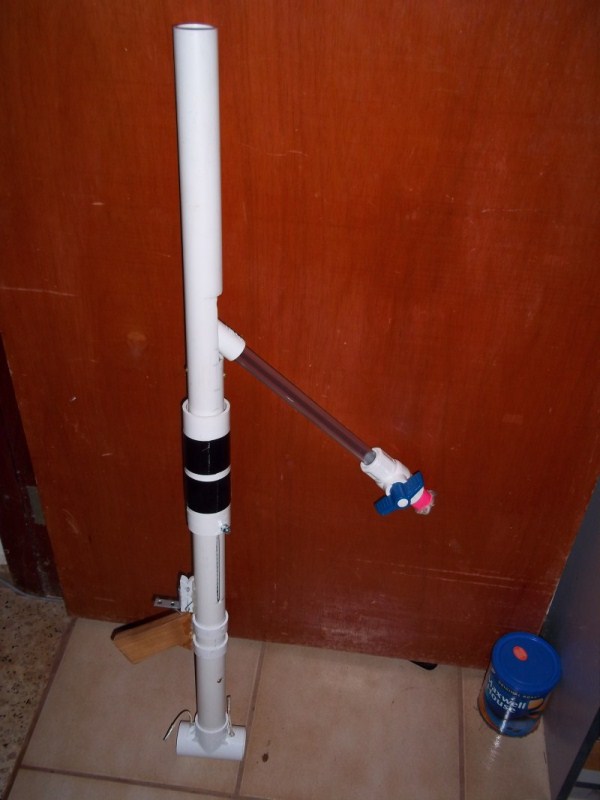Before I go into the writeup, I'd like to give credit to Daniel Beaver for some design aspects of the plunger rod, and to TantumBull for the ideas in his plunger-rod less snap.
Materials needed:
1 1/2” thinwall pvc
1 1/4” pvc
3/4” pvc
3/4” thinwall pvc
1/2” pvc
1/2” cpvc
1 1/4” pvc tee
3x 3/4” pvc endcap. At least one must have a rounded end
3/4” pvc coupler
3/4” to 1/2” pvc bushing
2x 1” to 1/2” pvc bushing
1/2” cpvc coupler
1/2” cpvc endcap
1/2” pvc wye or tee and coupler
1 or 2 clothespins
Roofing nail
L-bracket
12x 6-32 x 3/8” machine screws
8x 8-32 x 3/8” set screws
2x 6-32 x 1/2” machine scerws
1x 6-32 x 1 1/2” machine screw
1x 1/4-20 x 1 1/4” machine screw with nut
1x 1/4-20 x 2” machine screw with nut
A really short wood screw
2x 1 1/4” x 1/4” fender washers
1x 5/8” SAE washer
1x 1 1/4” rubber washer
1x 1 1/2” rubber washer
#10 finishing washer
1/4” ID nylon spacer
[k26] spring
A small spring to use as a trigger spring
Your barrel of choice
and various tapes and adhesives
Whew! That's a bit. Note that this was everything I used to make mine. Your parts list may change slightly based on your choices.
Now. Before we begin, I want to show you a picture of the barrel I used.

It's a 9/16” brass Brithop. (my darts are fat) The pvc part of it is 10 3/4” long. If you use a barrel that ends up with this part being longer or shorter, you will have to change some dimensions. I'll let you know which ones as we come to them.
Now let's start with the plunger head. This is a combination of the superlative and preeminent heads. The pvc ramp of the preeminent but the small size of the superlative. Drill a centered 1/4” hole in the cpvc endcap, then drill out a hole in the back of a 3/4” pvc endcap so that the cpvc one can fit through. If you have rounded and not-rounded pvc endcaps, you need a rounded one here.

Cut down the pvc endcap so that it is flush with the end of the cpvc one, and fill the space between them with epoxy putty.

Then sand it smooth.

Glue one of the 1 1/4 x 1/4 fender washers onto this. Make sure the hole is lined up with the one you drilled. Then assemble the rest of the head as you would a superlative. I assembled it all quickly so that the first washer could be held in place while the glue cured.

Cement your cpvc to the head. You need about 11” of it.

Next you'll need to make a small ring of pvc and/or fittings. All that really matters is that the outside rides in 1 1/4” pvc and the inside fits over cpvc. I used 3/4” pvc endcap (actually the part cut off of the one on the head should work), 3/4” pvc, and and sanded down cpvc coupler.

Now glue your 5/8” SAE washer to one side of it. The whole assembly should be 1/2” long. This piece is what the bolt in the priming slide pushes against to prime the blaster. The washer prevents the threads from digging into the pvc.

Slide this piece onto your plunger rod 6 3/8” from the back of the head.

Drill some 7/64 holes through it, and run your 6-32 x 1 1/2” screw all the way through, and your two 6-32 x 1/2” screws into the other sides. Cut off the heads flush with the edges of the pvc.

Cut down the plunge rod so it ends 3” past the back of this piece you just put on. Then bevel the outside edge.

You're done with the plunger rod. Onto the main body!
Cut a 30 5/8” piece of 1 1/4” pvc. If your barrel is longer or shorter than mine, you will need to change this dimension. If it's longer you could also just let the barrel stick out the front, but that would look like shit. You have a few slots to cut in the body now.
These are going to be some offset slots like on Daniel Beaver's pumpsnap. Drill 5/16” holes at 3 1/2” and 9 9/16” from the back of the body.

Connect these with a dremel, scrollsaw, or whatever.

To make the other slot, I inserted the plunger into the body, and put the drill bit through the slot I already cut, then around the plunger rod, and drilled through the other side. The end result is slots that will allow a bolt through without touching the plunger rod.

Ending at 12 5/8” from the front of the body (meaning that you mark there and cut forward), make a slot a little bigger than your wye. I did this after making the offset slots so I could line this up where I wanted: A little offset to the right.

Clean all the pvc shavings out of the body, and prepare to install the bushing. Instead of the normal 1” to 1/2” bushing wrapped in tape, I used a 3/4” endcap with a 3/4” to 1/2” bushing in it.

This fit better in the body than the 1” bushing, and was slightly shorter as well. Cement them together.

And cut the back of the endcap off flush with the back of the bushing.

Don't slather the assembly in goop right away. Slide it in through the front of the body until it's sitting in the wye slot you cut out.

Now you can cover it with your adhesive of choice. I used epoxy. Rotate it in the slot so you can get all around it. Then push it back until it's flush with the edge of the slot. Ignore the screws for a moment.

Once the epoxy cures, drill 8 9/64” x 3/8” deep holes into the bushing, and insert your set screws into these holes.

If (like me) your bushing lets air around between it and the 1 1/4” pvc body, you can dump hot glue into that nice little crevice made by the endcap and bushing to seal it.

Time for the spring rest. Sand the ridge inside a 3/4” pvc coupler until pvc goes all the way through it.

Cement this and an endcap onto some 3/4” thinwall pvc.

Then cut the pvc flush with the coupler.

Bevel the front edge.

Wrap this in packing tape until it fits snug in the 1 1/4” pvc. Then insert it into the back of the body until only the rounded part sticks out. Use four 6-32 x 3/8 screws to hold it in. These will need to come out soon, but it's easier to put the threads in now. Sorry for not having a picture of the screws, but it shouldn't be hard to figure out. You can see them later as well.

Part 2 coming in a moment.
Edited by snakerbot, 29 July 2011 - 06:59 PM.















































